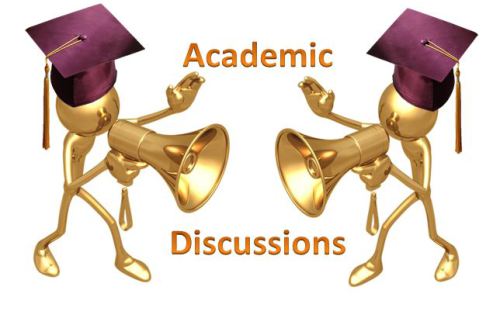Ten Pointers Promoting Academics In Online Discussions.. Digital Citizenship Series

Welcome to a post I am certain will help you, and many others, as you facilitate online discussion forums to promote real learning. First, to ensure you do not miss one of these valuable posts or other resources covering PBL, Digital Curriculum, Web 2.0, STEM, 21st century learning, and technology integration please sign up for 21centuryedtech by email or RSS. As always, I invite you to follow me on twitter (@mjgormans). Please give this post a retweet and pass it on. Have a great week – Michael Gorman (21centuryedtech)
By Michael Gorman at (http://21centuryedtech.wordpress.com)
In the last post we discussed how online discussions can incorporate many ideas that enrich a blended classroom. You may wish to explore these ten ideas in the last post. In this week’s post I would like to emphasize how you might want to emphasize that needed academic emphasis in student online discussions. Remember that an online discussion is a powerful extension of learning that can go beyond the walls of your classroom.
When using online discussions with student be sure to keep your point of emphasis aimed at the content standards, 21st century skills, while moving up Blooms higher levels. Questions can be convergent for formative purposes, but also divergent to promote inquiry. Remember that the use of multimedia can promote academic standards while facilitating real and meaningful discussion. The teacher should model proper digital citizenship, constantly monitor student communication, and also provide responses to various discussion threads. Equally important, the teacher should be aware and follow the District AUP (Acceptable Use Policy) and any website terms of use.
When first joining the world of student online discussions it can be often noted that the student conversation is not always highly academic and sometimes lacks rigorous thought. After all, students have already learned to digitally communicate using social media and they transfer this past practice to the academic classroom. It is important that teachers facilitate proper online communication while promoting digital citizenship. Through proper guidance and digital education any classroom can discover the rich and meaningful opportunities that an online discussion can provide. Please feel free to use these ten ideas below and share with others.
1. Keep discussions to Bloom’s higher level topics including creating, evaluating, and synthesizing.
2. Use discussion as a formative assessment for checking both individual and group understanding. This does not mean it always has to be graded for accuracy… but more as a way for the teacher to plan. Many times in this method, the question maybe lower on Blooms Scale to show remembering and understanding.
Tools and ideas to transform education. Sign up below.
3. A discussion can be graded, although it maybe best to grade for participation. In this manner the teacher may post and then ask students to reply to teacher post with a requirement of so many sentences. There could also be a requirement to comment to stated number of other student posts. When grading be specific on requirements.
4. A class discussion is not a emulation of social media, it is an academic forum. This should be stated in the discussion question until it becomes acceptable classroom practice. and culture. Some things to keep in mind are the following.
- Proper English grammar
- Complete sentences
- No use of text lingo (example; LOL”
- Any copy and pasted resources or reference should be at least cited by name and link
- Topic should be adhered to, no outside or side bar conversation
- Proper spelling of words
- Thoughts and ideas should be concise and to the point (do not ramble)
- When stating positives and agreements be specific as to reasoning… keep away from Yearbook type comments
- Exercise proper Digital Citizenship (see below)
5. Students should practice proper digital citizenship
- Empathy for others should be practiced with an understanding of an individual’s writing before commenting
- No use of text lingo (example; LOL)
- Proper peer critique should be emphasized with an emphasis on caring (example… do not be critical, instead use I wonder statements)
- All comments should be academic (See above)
- Do not use personal identifying information
- No plagiarizing… give credit
- There should be no bullying or put downs
6. Mix up media in discussions… do not always have them text based. Use documents, PDF files, movies, music, sound files, Power Points, website links, and images to promote the standards and concepts.
7. Keep on topic… try to provide discussions that will support the standards and 21st skills that you wish to emphasize and that will be assessed.
8. Use a rubric if providing a discussion for understanding. Make sure your students are aware and use the rubric when making any comments or replies. Possibly include the 21st century skills of Communication, Critical Thinking, Collaboration, and Creativity. Do not try to include all, and break these skills down to individual components. Example… instead of Creativity use one component such as divergent thinking.
9. As a teacher be sure to model by practicing what is required, while also commenting on what students write.
10. Encourage students to create their own discussions so they begin to own the process.
cross-posted at 21centuryedtech.wordpress.com
Michael Gorman oversees one-to-one laptop programs and digital professional development for Southwest Allen County Schools near Fort Wayne, Indiana. He is a consultant for Discovery Education, ISTE, My Big Campus, and November Learning and is on the National Faculty for The Buck Institute for Education. His awards include district Teacher of the Year, Indiana STEM Educator of the Year and Microsoft’s 365 Global Education Hero. Read more at 21centuryedtech.wordpress.com.
